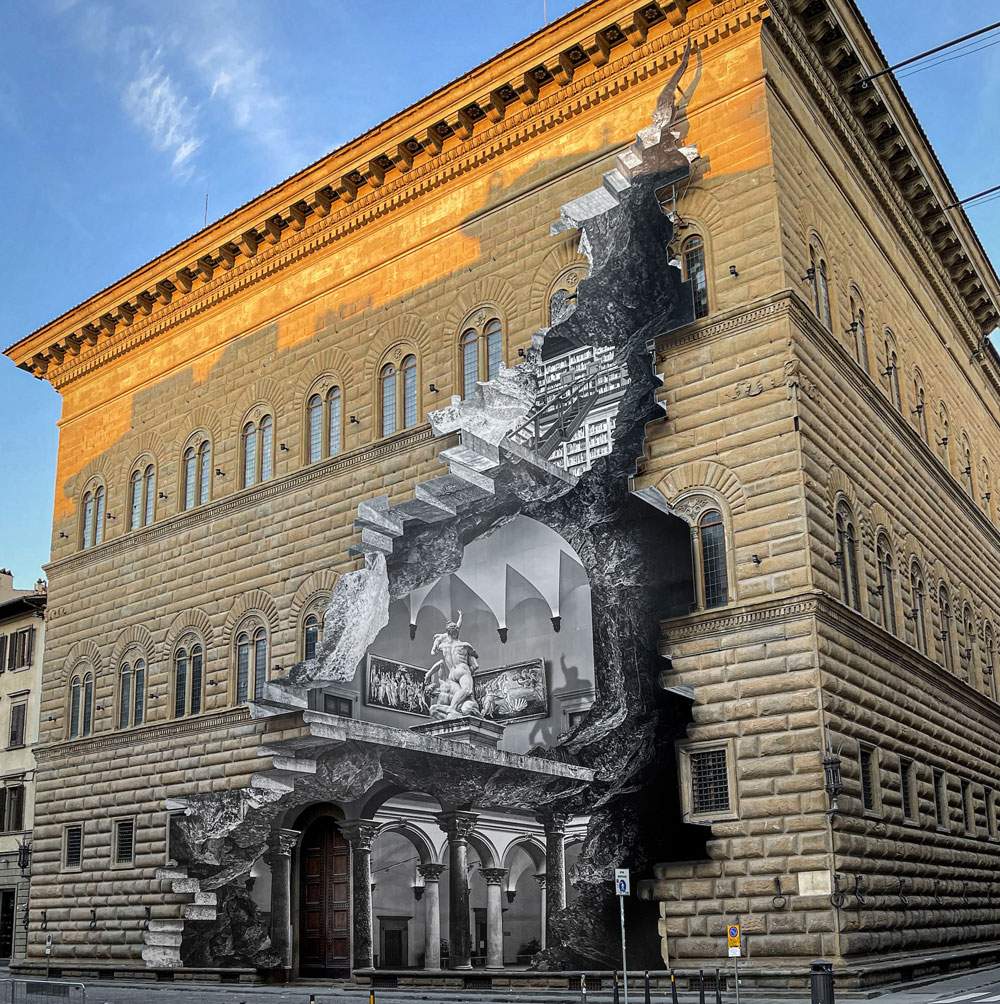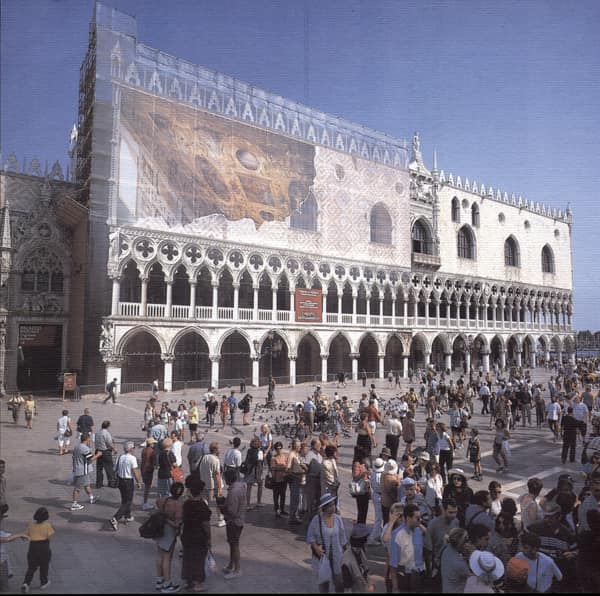“L’histoire de l’art depuis cent ans est l’histoire de ce qui est photographiable,” the history of art of the last hundred years is the history of what is photographable. André Malraux said this in his 1947 Le Musée imaginaire, and his sentence could be reversed today: the history of art in recent years is the history of what is Instagrammable. Street artist JR, who is French and probably knows both Malraux and Instagram well, understood this better than anyone: the art that is successful in this part of the 21st century is Instagram-friendly art. Whether we are talking about an obscure urban artist from a Polish suburb or about the street artist in the system who can afford to hang an anamorphosis collage on the facade of Palazzo Strozzi, it matters little: what matters is to leverage the social presentability of one’s work, which must be imagined from the outset in order for it to render well on the public’s screens. This was candidly admitted by JR himself, in an interview today with Corriere della Sera: “This installation of mine,” he says, “you see it better when you photograph it. Lanamorphosis can be seen well only from a specific point of view, and I studied it so that this image can be shared as much as possible by cell phones.”
Better, of course, if it is all in giant size. Just yesterday, on these pages, we were pointing out Ugo Nespolo’s new book, which has just come out: reading it, one dwells on his, whether or not one shares it, “sense of repulsion-attraction for that spectacle, exterior art, so much used and abused today, made up of mastodontic, intrasportable apparatuses always exhibited as a gesture of force and therefore of power. Discouragement in the face of the visual impositions of certain immobile presences, alive - like the shanties at fairs - only until the day of disassembly.” Art that enchants happy audiences but fails to move them, apparatuses that, Nespolo concludes, “are always irrelevant and therefore never memorable.” Consumer art(absit iniuria verbis) for an age when everything is consumed. Tons of paper, canvas, ink, plywood and various materials that at best will be recycled after generating millions of likes, will have enchanted the public and especially collectors, though probably without leaving big traces. Of course, there is nothing wrong with that: if the idea is to get the work to be shared as much as possible on the public’s cell phones, then there is a perfect alignment between the artist’s concrete intentions and the goal.
And this despite The Wound (this is the title of the work) not being so original or innovative, one would think. The idea of opening a glimpse into the palace to show the interior (albeit reinvented for the occasion by JR, who inside Palazzo Strozzi squares Botticelli’s Venus and Spring and Giambologna’s Rape of the Sabine Women: in the historic center of Florence everything must be immediately recognizable and reassuring, and so it is only right that the usual ode to icons should be raised) does not represent anything particularly innovative, as my friend Lorenzo Bonoldi points out to me, who recalls how back in the early 2000s a scaffolding company working on the facade of the Doge’s Palace in Venice had already experimented with the gimmick: a giant poster with an exact reproduction of the building’s interior had been installed to cover the construction site, for the use of those who could not see the exterior undergoing the work. In short, one might think that a kind of large advertising banner ended up on the facade of Palazzo Strozzi, well successful in its most repressed intent.
 |
| JR’sThe Wound (photo by JR). |
 |
| Scaffolding by the Ecoponteggi company on the facade of the Doge’s Palace in Venice in the early 2000s |
Of course: JR also did “interesting things,” as they say. He has, meanwhile, had the insight to insert himself as an insider in the groove of the decades-long tradition of social complaint photography. Without getting too involved, however: “my project,” he declared in 2006 on France 2, which interviewed him about his most famous work, 28 Millimeters, “is not a political or social project, it is first and foremost an artistic project, which is why I am not the spokesperson for the young people of Clichy: I am not trying to change things in this way, it is a project we did together, but I am very happy with the fact that through these works the image of these young people is bambiated.” Then, he strategically went for gigantism from the start, applied some typical paradigms of relational art, had the foresight to hang his mega-portraits in Gaza and in the favelas of Rio de Janeiro. With the usual detachment: he does not want to lavish himself in direct engagement, but merely works with local communities “engaging an audience made up in particular of groups considered marginalized,” wrote critic Suzanne Lacy, “as active participants in the production of a process-oriented, and politically conscious, program or event.” And so it became JR, and the step to institutionalization was a short one.
Enthusiasts credit him with the ability to give voice to the communities he encounters for his projects. “More than the photo itself,” Forbes wrote, “what is fascinating about JR is the artistic process and the involvement of people. Each of his projects is a collective adventure that calls the public to participate, and people play a vital role not only as spectators but also become the subjects and actors who choose how much impact the installation will have.” And JR recoils: it is the community that creates the project. Nothing that many other photographers active on the same kind of content haven’t already done, but the declination of this model according to a mélange that combines street art and relational art has guaranteed him success.
In Florence evidently there must have been a paradigm shift, however. Says Palazzo Strozzi director Arturo Galansino that “JR’s new work represents a strong signal of reflection on the difficult conditions of access to culture in the era of Covid-19.” Indeed, after a year of almost uninterrupted house arrest we felt precisely the need for someone to invite us to reflect on how difficult it is to access culture when governments halfway across Europe insist on keeping it locked up. Unfortunately, we have been reflecting for a year now (indeed: for much longer, if we consider more generally the conditions of culture in Italy), and this work seems to succeed in its intent to provoke: it appears superficial, banal, didactic, and accommodating. It fails to suggest anything more than what it shows, which is a divertissement somewhere between the anamorphoses of Julian Beever, the street artist who paints fake chasms on city streets (and has always been very popular on social media, by the way), Piranesi’s constructions, and Aescherian aesthetics. It does not disturb or unsettle: and perhaps never as in these months would we need to be disturbed to be called to action (in France, in JR’s country, they are occupying theaters, with a much more provocative, disturbing and perhaps even more artistic action). Perhaps it does not even involve, except to take a few photographs to post on Instagram.
It is a work that, unfortunately, seems to be perfect for an artworld that has extensively resigned itself to governmental impositions (by now well introjected by the citizenry, which when faced with changes in risk zones reacts as it does when they tell it that as of tomorrow they are changing the hours of the registrar’s office in the municipality), and who by now would seem to no longer even have the strength to ask to be put in a position to work when it could be done safely under the safety conditions that Covid imposes, since by now there are no longer any valid scientific and political reasons to continue the lockout to the bitter end, which hopefully will be lifted soon anyway, rendering JR’s primal message inactual. Who as a good strategist probably had the alternative message ready in case his installation arrived with the museums already open, and just as likely would have told us about freedom, creative imagination and participation as means to restart after the confinements.
However one wants to see it, the work seems to go no further than lockdown rhetoric. It almost seems to be the translation into images of the paternals of politics that has never ceased to remind us how deep the wound of closed cultural venues is, and yet it is not possible to do otherwise, so we have to be content to see it from the outside, through a reproduction. With his work, JR reassures us: it is as if he is saying that unfortunately this is the situation now, that we have to be content to see art from the outside, but soon we will return to populate museums. A pop message for pop art that the public likes, the politicians like, the press likes. And that therefore should be appreciated.
Warning: the translation into English of the original Italian article was created using automatic tools. We undertake to review all articles, but we do not guarantee the total absence of inaccuracies in the translation due to the program. You can find the original by clicking on the ITA button. If you find any mistake,please contact us.